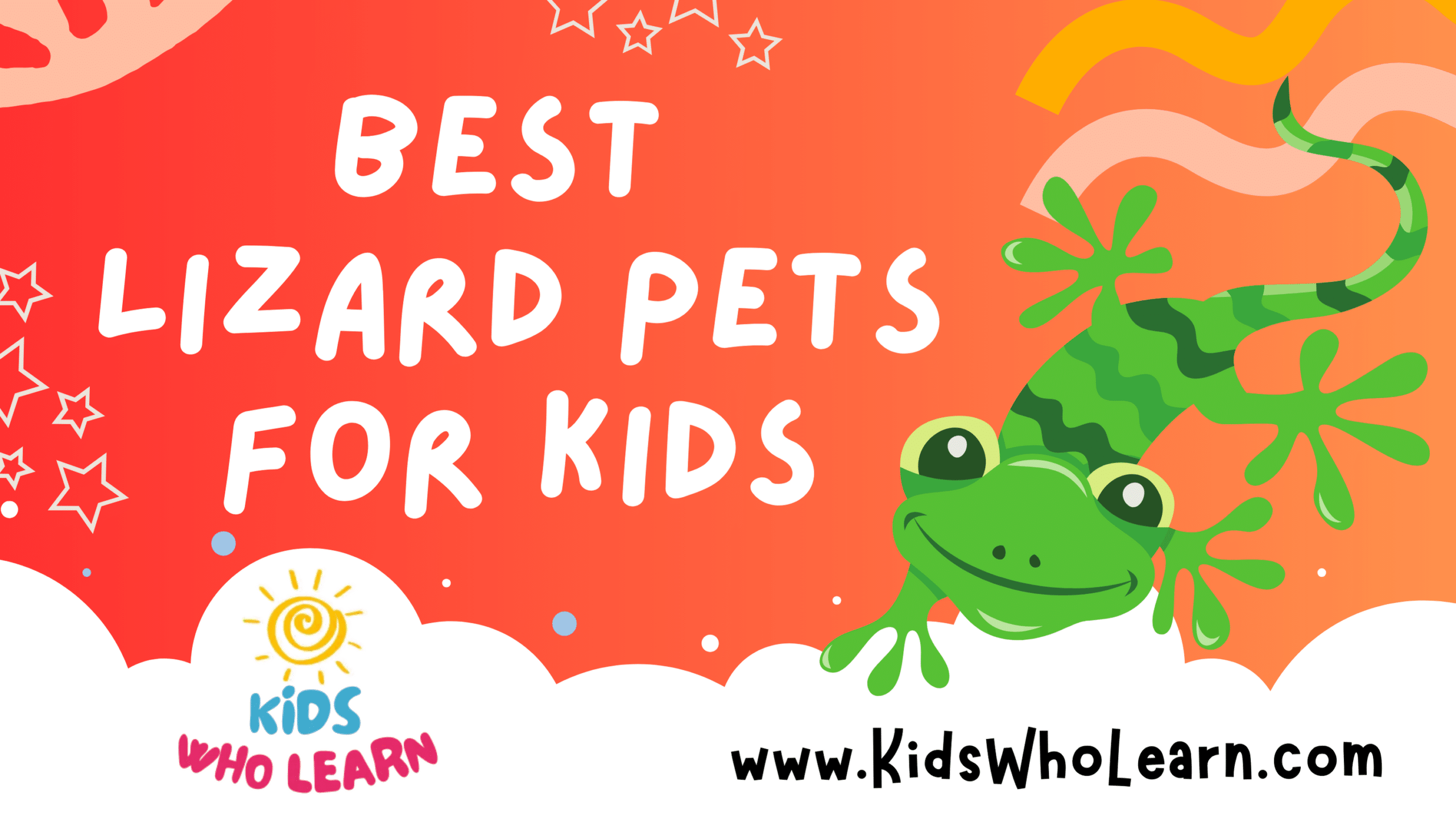Selecting a pet lizard can be exciting, especially for children eager to learn about exotic creatures. Lizards can be ideal first pets for young ones as they often have minimal care requirements and can teach responsibility. It’s crucial to opt for a species that is known for its docile nature and low maintenance needs. Our experience with various types of lizards has revealed that some species stand out as particularly suitable for children.
When choosing a lizard pet, it’s essential to consider the size of the lizard, its habitat needs, and its overall temperament. Some lizard species are more interactive, making them more engaging for kids who are curious and eager to form a bond with their new pet. Additionally, creating a proper habitat is vital for the lizard’s health and well-being, and it provides an excellent opportunity for kids to learn about the importance of environment and routine care.
Key Takeaways
- Lizards can be great first pets that require minimal care and teaching responsibility.
- It is important to choose a child-friendly lizard species known for its gentle temperament and manageable size.
- Proper habitat creation and routine care are essential for the lizard’s health and allow kids to engage in learning about their pet’s needs.
Choosing the Right Lizard Pet for Your Child
When selecting a lizard pet for children, we must focus on species with a docile temperament and manageable size, ensuring a positive experience for the child and the pet.
Factors to Consider
When we’re considering pet lizards for kids, safety and ease of care are paramount. Here’s what we need to assess:
- Interaction: Some lizards tolerate handling better than others. It’s important for a child-friendly pet to be amenable to gentle handling.
- Care Requirements: We should look for species with straightforward dietary and habitat needs that match the family’s ability to provide care.
- Space: The size of the lizard’s required habitat relative to available space in the home should be taken into account.
Personality and Temperament
A lizard’s personality is a critical factor since we want a pet that is friendly and docile. A few species known for their placid nature are:
- Leopard Gecko: These lizards are known for their calm demeanor, making them ideal for regular handling.
- Bearded Dragon: They tend to be sociable and comfortable with human interaction, often showing distinct personalities.
Size and Lifespan
We should also consider the size and lifespan of the lizard as they both have long-term implications:
- Bearded Dragons: They can grow up to 24 inches and live 10-15 years.
- Leopard Geckos: Smaller in size, they may reach 10 inches and can live up to 20 years, making them a long-term commitment.
- Crested Geckos: Moderate in size, with a manageable lifespan for a child’s pet.
By carefully considering these factors, we can help ensure that the chosen pet lizard is suitable and enjoyable for kids to care for over its lifetime.
Popular Lizard Species for Kids
We understand that finding the right pet lizard for your child involves considering their temperament, care needs, and the appeal they may have to young enthusiasts. Here’s a look at some popular lizard species that are known for being beginner-friendly and enjoyable companions for kids.
Leopard Gecko
Scientific Name: Eublepharis macularius
Temperament: Docile and easy to handle
Care Level: Easy
Leopard geckos are a top choice due to their non-aggressive nature and the variety of colors they come in. They do not require a complex diet, primarily consisting of insects, and their calm demeanor makes them an excellent beginner pet.
Bearded Dragon
Scientific Name: Pogona vitticeps
Temperament: Friendly
Care Level: Moderate
These lizards showcase a range of behaviors that fascinate kids and are generally very tame. Bearded dragons require a varied diet including vegetables and insects. Their attentive and relaxed presence makes them a popular choice.
Crested Gecko
Scientific Name: Correlophus ciliatus
Temperament: Gentle
Care Level: Easy
Crested geckos are known for their unique eyelash-like crests and the ease with which they can be cared for. They mostly consume fruit-based gecko diet mixes supplemented with insects and have a docile nature that’s great for kids.
Blue-Tongued Skink
Scientific Name: Tiliqua spp.
Temperament: Easy-going
Care Level: Moderate
The distinct blue tongue and friendly attitude of these skinks make them a fascinating pet. They have a more omnivorous diet requiring both plants and proteins. Their calm temperament and hefty size make them suitable for older children.
Green Anole
Scientific Name: Anolis carolinensis
Temperament: Skittish but manageable
Care Level: Easy
Green anoles are smaller and require a simpler habitat. They have a diet of small insects and their relatively low maintenance care makes them a decent option for an introductory pet lizard. Their vibrant colors are especially appealing to kids.
Setting Up the Habitat
When we create a habitat for a pet lizard, our goal is to mimic their natural environment as closely as possible. This includes providing the right type of substrate, decor for hiding and climbing, and ensuring appropriate temperature and humidity levels. Careful attention to these details helps promote the health and well-being of the lizard.
Habitat Requirements
Our first step is to select an enclosure of the appropriate size and shape. The size depends on the species of lizard; some may require a tall tank for climbing, while others need more floor space for roaming. It’s crucial to choose an enclosure that provides space for a temperature gradient and enough room for the lizard to move around freely.
Substrate and Decor
Substrate is the material we place on the bottom of the habitat. For many lizards, a layer of reptile carpet, coconut fiber, or specially formulated reptile bark works well. Avoid using sand, especially for young or small lizards, as it can lead to impaction if ingested.
When it comes to decor, we must provide a variety of branches, rocks, and hides. These elements offer our lizard places to hide, which supports their need for security, and branches promote natural climbing behavior. Additionally, ensure there’s a designated basking area where the lizard can absorb heat.
Temperature and Humidity Control
Regulating temperature and humidity is crucial. We use thermometers and hygrometers to monitor these conditions:
- Basking light: Place a basking light at one end of the tank to create a temperature gradient with a hot spot where the lizard can warm up.
- UVB lighting: Install a UVB bulb to simulate sunlight, which is essential for most lizards to synthesize vitamin D3 for calcium absorption.
| Zone | Temperature Range |
|---|---|
| Basking Spot | 85-120°F (29-49°C) |
| Cool Side | 70-85°F (21-29°C) |
To maintain proper humidity:
- Mist the enclosure regularly, or install an automatic mister for consistent moisture.
- Provide a shallow water dish large enough for the lizard to soak if desired, which also aids in humidity levels.
Keep thermometers and hygrometers at both ends of the enclosure to ensure the entire gradient is within the proper range.
Feeding Your Lizard
Proper nutrition is pivotal for your lizard’s health. We’ll help you understand their dietary needs and guide you on safe foods and supplements.
Understanding Dietary Needs
Lizards are diverse creatures, and their dietary requirements can vary significantly from species to species. Typically, they fall into one of three dietary categories: insectivores, herbivores, or omnivores. Insectivores require a diet predominantly made up of live insects such as crickets and mealworms. These should be gut-loaded (fed nutritious foods) before being offered to your lizard to ensure they are rich in nutrients. Herbivores thrive on a diet of leafy greens and vegetables, with occasional fruits added for variety. Omnivores benefit from a mixed diet that incorporates both plant-based foods and insects.
Calcium is an essential supplement for most lizards, particularly for growing juveniles and breeding females. We often dust food with a calcium powder to prevent bone deficiencies. Additionally, vitamin D3 supplements are crucial when UVB lighting is insufficient, as they aid in calcium absorption.
Safe Foods and Supplements
Here’s a simple guide to help you provide a balanced diet for your lizard:
| Safe Insects | Safe Greens and Vegetables | Safe Fruits |
|---|---|---|
| Crickets | Collard greens | Papaya |
| Mealworms | Mustard greens | Mango |
| Dubai roaches | Bell peppers | Blueberries |
| Waxworms (sparingly) | Carrots | Figs (sparingly) |
Remember to provide a variety of foods to cover the dietary spectrum and avoid nutritional deficiencies. Always choose fresh, pesticide-free produce and avoid feeding your lizard anything with a high oxalate content, as it can inhibit calcium absorption.ibName
Health and Maintenance
Proper health and maintenance are crucial in ensuring that our scaly friends lead happy, healthy lives. We will explore the daily care they require and how to address any health issues that may arise.
Daily and Regular Care
Our daily routine includes monitoring their habitat for cleanliness and maintaining a consistent feeding schedule. Here’s a breakdown of what we need to do:
- Feeding: Offer a diet suitable for the specific species of lizard. Most enjoy a combination of insects like crickets or mealworms and leafy greens.
- Habitat Cleanliness: We keep the enclosure clean by removing uneaten food, waste, and shedding skin daily to prevent bacterial growth.
- Temperature and Lighting: It is essential to routinely check that the temperature gradients and lighting are at optimal levels to mimic their natural environment.
- Gentle Handling: We practice gentle handling regularly to build trust, but we must also recognize when our pet needs time alone to reduce stress.
Identifying and Addressing Health Issues
To identify health issues in our lizards, we observe their behavior and physical condition closely. Key indicators of health problems could include lethargy, lack of appetite, discoloration, or abnormal shedding. Here are our actions when such signs are present:
- Consult a Veterinarian: If we suspect health issues, it is our responsibility to consult with a reptile veterinarian for professional advice.
- Quarantine If Necessary: If we own multiple reptiles and detect an illness, we quarantine the affected lizard to prevent transmission of possible infectious conditions.
By staying alert and responsive to our lizard’s needs, we ensure they receive the care required to thrive.
Benefits of Lizard Ownership for Kids
When considering pet reptiles for children, lizards can provide significant educational value and help in developing responsibility. Our focus is on how these fascinating animals can contribute positively to a child’s growth.
Educational Value
We find that lizards offer a hands-on way to learn about biology and the natural world. Kids can observe the lizard’s life cycle, behaviors, and habitat needs firsthand, which enhances their understanding and appreciation for living things. They can learn about:
- Anatomy: Children see how lizards shed their skin and may learn about reptilian anatomy.
- Ecosystems: By maintaining a lizard’s habitat, kids discover what these creatures need to thrive.
Developing Responsibility
Caring for a lizard requires a daily commitment. This task, when guided appropriately, teaches children about the responsibility of caring for another living being. Responsibilities include:
- Feeding: Kids must ensure the lizard is fed regularly, learning about dietary needs.
- Habitat Maintenance: Regular cleaning and monitoring of the habitat teach kids the importance of cleanliness and environmental control.
Frequently Asked Questions
In this section, we’ll address common inquiries about selecting and caring for a young child’s first lizard pet, focusing on aspects like ease of care, friendly species, and safety in handling.
What are the best starter lizards for a child’s first pet?
The best starter lizards for children include the Leopard Gecko, Crested Gecko, and Blue-Tongued Skink. These species are known for their docile nature and relatively straightforward care requirements, making them excellent choices for novices.
Which lizard species are known for being particularly friendly to humans?
Bearded dragons and Leopard Geckos are among the friendliest lizard species. They typically enjoy being handled and are less likely to feel stressed when interacting with humans, which is great for building a bond with a child.
What should be considered when selecting a terrarium pet for a beginner?
When selecting a terrarium pet for a beginner, consider the lizard’s adult size, habitat needs, diet, and temperament. Beginners should look for species that don’t grow too large, have manageable habitat requirements, and have a calm disposition.
How easy is it to care for bearded dragons, and are they suitable for children?
Bearded dragons are quite easy to care for and very suitable for children. They require a warm environment, a balanced diet of insects and vegetables, and regular, gentle handling to maintain tameness. Their friendly and interactive nature makes them a popular choice for families.
Can you recommend any low-maintenance reptiles that are ideal for busy families?
For busy families, the Leopard Gecko is a low-maintenance option. This species does not require UV lighting, which reduces care complexity, and it has a simple diet of insects. They are also known to be hardy and do not require frequent handling.
Is it safe for children to handle pet lizards, and if so, which ones?
It is generally safe for children to handle pet lizards such as Bearded Dragons, Leopard Geckos, and Crested Geckos under supervision. It’s important to teach children how to gently handle these animals to avoid distress. Always ensure good hygiene is practiced, including thorough hand washing before and after handling any reptile.











